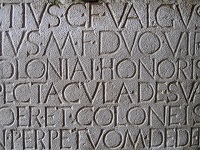Difference between revisions of "How to Count in Latin"
m (pictures adjusted) |
|||
| Line 5: | Line 5: | ||
=== Learn Cardinals === | === Learn Cardinals === | ||
==== Learn From One to Nine ==== | ==== Learn From One to Nine ==== | ||
#Learn counting cardinals from one to nine in Latin [[Image:LatinCte21.jpg|right| | #Learn counting cardinals from one to nine in Latin [[Image:LatinCte21.jpg|right|150px|thumb|Augustus]] | ||
#* One: '''Un'''us | #* One: '''Un'''us | ||
#* Two: '''Duo''' | #* Two: '''Duo''' | ||
| Line 27: | Line 27: | ||
#* Nineteen: Undeviginity (actually, one to twenty) | #* Nineteen: Undeviginity (actually, one to twenty) | ||
==== Learn Multiples of Ten ==== | ==== Learn Multiples of Ten ==== | ||
[[Image:LatinCte22.jpg|right| | [[Image:LatinCte22.jpg|right|150px|thumb|Julius Caesar]] | ||
# Now it is time to learn multiples of ten : | # Now it is time to learn multiples of ten : | ||
#* Ten: Decem | #* Ten: Decem | ||
| Line 40: | Line 40: | ||
==== Learn Multiples of Hundred and Thousand ==== | ==== Learn Multiples of Hundred and Thousand ==== | ||
#Learn multiples of hundred : [[Image:LatinCte23.jpg|right| | #Learn multiples of hundred : [[Image:LatinCte23.jpg|right|150px|thumb|Cicero]] | ||
#* Hundred: Centum | #* Hundred: Centum | ||
#* Two-hundred: Ducenti | #* Two-hundred: Ducenti | ||
| Line 68: | Line 68: | ||
#* Seven-hundred and eighty-five: Septingenti octoginta quinque | #* Seven-hundred and eighty-five: Septingenti octoginta quinque | ||
=== Learn Adverbials === | === Learn Adverbials === | ||
[[Image:LatinCte24.jpg|right|200px|thumb| | [[Image:LatinCte24.jpg|right|200px|thumb|Latin, Language of Church]] | ||
#Adverbials (the numeral adverbs) define the answer to "how many times?" | #Adverbials (the numeral adverbs) define the answer to "how many times?" | ||
#Note that, some how like English you might interpret Latin "ies" as "times." | #Note that, some how like English you might interpret Latin "ies" as "times." | ||
| Line 83: | Line 83: | ||
#* Nine times: Novies | #* Nine times: Novies | ||
==== Learn From Eleven to Nineteen ==== | ==== Learn From Eleven to Nineteen ==== | ||
[[Image:LatinCte25.jpg|right| | [[Image:LatinCte25.jpg|right|200px|thumb|Latin, Language of Science]]#Learn adverbials from eleven to nineteen : | ||
#* Eleven times: Undecies | #* Eleven times: Undecies | ||
#* Twelve times: Duodecies | #* Twelve times: Duodecies | ||
| Line 106: | Line 106: | ||
#* Ninety times: Nonagies | #* Ninety times: Nonagies | ||
==== Learn Multiples of Hundred and Thousand ==== | ==== Learn Multiples of Hundred and Thousand ==== | ||
#Learn multiples of hundred for adverbials: [[Image:LatinCte26.jpg|right| | #Learn multiples of hundred for adverbials: [[Image:LatinCte26.jpg|right|200px|thumb|Classic Latin]] | ||
#* Hundred times: Centies | #* Hundred times: Centies | ||
#* Two-hundred times: Ducenties | #* Two-hundred times: Ducenties | ||
| Line 124: | Line 124: | ||
==== Learn Smaller number Between These Numbers ==== | ==== Learn Smaller number Between These Numbers ==== | ||
[[Image:LatinCte27.jpg|right| | [[Image:LatinCte27.jpg|right|200px|thumb|Ancient Latin]]# To build numeral adverb change each cardinal to its adverbial form. Hence, | ||
#* Forty-seven times: Septies et quadragies | #* Forty-seven times: Septies et quadragies | ||
#* Fifty-six times: Sexies et quinquagies | #* Fifty-six times: Sexies et quinquagies | ||
| Line 135: | Line 135: | ||
Ordinals define the answer to "which in a row?" | Ordinals define the answer to "which in a row?" | ||
==== Learn From One to Nine ==== | ==== Learn From One to Nine ==== | ||
[[Image:LatinCte28.jpg|right| | [[Image:LatinCte28.jpg|right|200px|thumb|Latin, Culture]]#Learn ordinals from one to nine in Latin. | ||
#* First: Primus | #* First: Primus | ||
#* Second: Secundus | #* Second: Secundus | ||
| Line 169: | Line 169: | ||
#* Ninetieth: Nonag'''esimus''' | #* Ninetieth: Nonag'''esimus''' | ||
==== Learn Multiples of Hundred and Thousand ==== | ==== Learn Multiples of Hundred and Thousand ==== | ||
[[Image:LatinCte29.jpg|right|200px|thumb|Latin, | [[Image:LatinCte29.jpg|right|200px|thumb|Latin, Medieval]]#Learn multiples of hundred for ordinals: | ||
#* Hundredth: Cent'''esimus''' | #* Hundredth: Cent'''esimus''' | ||
#* Two-hundredth: Ducent'''esimus''' | #* Two-hundredth: Ducent'''esimus''' | ||
| Line 187: | Line 187: | ||
==== Learn Smaller number Between These Numbers ==== | ==== Learn Smaller number Between These Numbers ==== | ||
[[Image:LatinCte30.jpg|right| | [[Image:LatinCte30.jpg|right|200px|thumb|Evolution of Alphabets]]# To build ordinals change each cardinal to its ordinal form. Hence, | ||
#* Forty-seventh: Septimus et quadragesimus | #* Forty-seventh: Septimus et quadragesimus | ||
#* Fifty-sixth: Sextus et quinquagesimus | #* Fifty-sixth: Sextus et quinquagesimus | ||
| Line 209: | Line 209: | ||
#* Nine for each: Noveni | #* Nine for each: Noveni | ||
==== Learn From Eleven to Nineteen ==== | ==== Learn From Eleven to Nineteen ==== | ||
#Learn from eleven to nineteen : [[Image:LatinCte31.jpg|right| | #Learn from eleven to nineteen : [[Image:LatinCte31.jpg|right|150px|thumb|Lucretius]] | ||
#* Eleven for each: Undeni | #* Eleven for each: Undeni | ||
#* Twelve for each: Duodeni | #* Twelve for each: Duodeni | ||
| Line 232: | Line 232: | ||
#* Ninety for each: Nonageni | #* Ninety for each: Nonageni | ||
==== Learn Multiples of Hundred and Thousand ==== | ==== Learn Multiples of Hundred and Thousand ==== | ||
[[Image:LatinCte32.jpg|right| | [[Image:LatinCte32.jpg|right|150px|thumb|Virgil]]#Learn multiples of hundred : | ||
#* Hundred for each: Centeni | #* Hundred for each: Centeni | ||
#* Two-hundred for each: Duceni | #* Two-hundred for each: Duceni | ||
Revision as of 14:46, 3 March 2014
Latin is a language not spoken by any modern nation. Such a language normally is called a dead (extinct) or ancient language. Surprisingly, Latin is a modern language learned by millions of people for different reasons and also is used within scientific world of all nations. Latin numbers have their own significance.
Steps
Latin numerals have cardinal, ordinal, distributive, and numeral-adverbial forms.
Learn Cardinals
Learn From One to Nine
- Learn counting cardinals from one to nine in Latin
- One: Unus
- Two: Duo
- Three: Tres
- Four: Quattuor
- Five: Quinque
- Six: Sex
- Seven: Septem
- Eight: Octo
- Nine: Novem
Learn From Eleven to Nineteen
- Learn from eleven to nineteen :
- Eleven: Undecim
- Twelve: Duodecim
- Thirteen: Tredecim
- Fourteen: Quattuordecim
- Fifteen: Quindecim
- Sixteen: Sedecim
- Seventeen: Septendecim
- Eighteen: Duodeviginity (actually, two to twenty)
- Nineteen: Undeviginity (actually, one to twenty)
Learn Multiples of Ten
- Now it is time to learn multiples of ten :
- Ten: Decem
- Twenty: Viginity
- Thirty: Triginta
- Forty: Quadraginta
- Fifty: Quinquaginta
- Sixty: Sexaginta
- Seventy: Septuaginta
- Eighty: Octoginta
- Ninety:Nonaginta
Learn Multiples of Hundred and Thousand
- Learn multiples of hundred :
- Hundred: Centum
- Two-hundred: Ducenti
- Three-hundred: Trecenti
- Four-hundred: Quadringenti
- Five-hundred: Quingenti
- Six-hundred: Sescenti
- Seven-hundred: Septingenti
- Eight-hundred: Octingenti
- Nine-hundred: Nongenti
- And at last,
- Thousand: Mille
- Two-thousand: Duo milia
- Three-thousand: Tre milia
- hundred-thousand: Centum milia
- And a million: Deciec centena milia (actually ten-hundred-thousand)
Learn Smaller number Between These Numbers
- Once you know the larger numbers, knowing small numbers is easy in Latin.
- In Latin , in contrast to English, they say seven and forty not forty-seven. Hence,
- Forty-seven: Septem et quadraginta
- Fifty-six: Sex et quinquaginta
- Eighty-five: Quinque et octoginta
- This goes until we get to one-hundred where order of words becomes like English. Thus,
- Hundred and forty-seven: Centum quadraginta septem
- Three-hundred and fifty-six: Trecenti quinquaginta sex
- Seven-hundred and eighty-five: Septingenti octoginta quinque
Learn Adverbials
- Adverbials (the numeral adverbs) define the answer to "how many times?"
- Note that, some how like English you might interpret Latin "ies" as "times."
Learn From One to Nine
- Learn numeral adverbs from one to nine in Latin.
- Once: Semel
- Twice: Bis
- Thrice: Ter
- Four times: Quater
- Five times: Quinquies
- Six times: Sexies
- Seven times: Septies
- Eight times: Octies
- Nine times: Novies
Learn From Eleven to Nineteen
#Learn adverbials from eleven to nineteen :
- Eleven times: Undecies
- Twelve times: Duodecies
- Thirteen times: Ter decies (written separate)
- Fourteen times: Quater decies (written separate)
- Fifteen times: Quinquies decies (written separate)
- Sixteen times: Sexies decies (written separate)
- Seventeen times: Septies decies (written separate)
- Eighteen times: Duodevicies
- Nineteen times: Undecies
Learn Multiples of Ten
- Now learn numeral adverbs multiples of ten :
- Ten times: Decies
- Twenty times: Vicies
- Thirty times: Tricies
- Forty times: Quadragies
- Fifty times: Quinquagies
- Sixty times: Sexagies
- Seventy times: Septuagies
- Eighty times: Octogies
- Ninety times: Nonagies
Learn Multiples of Hundred and Thousand
- Learn multiples of hundred for adverbials:
- Hundred times: Centies
- Two-hundred times: Ducenties
- Three-hundred times: Trecenties
- Four-hundred times: Quadringenties
- Five-hundred times: Quingenties
- Six-hundred times: Sexcenties
- Seven-hundred times: Septingenties
- Eight-hundred times: Octingenties
- Nine-hundred times: Nongenties
- And at last,
- Thousand times: Milies
- Two-thousand times: Bis milies
- Three-thousand times: Ter milies
- hundre-thousand times: Centies milies
- And a million times: Decies centies milies
Learn Smaller number Between These Numbers
# To build numeral adverb change each cardinal to its adverbial form. Hence,
- Forty-seven times: Septies et quadragies
- Fifty-six times: Sexies et quinquagies
- Eighty-five times: Quinqies et octogies
- Hundred and forty-seven times: Centies quadragies septies
- Three-hundred and fifty-six times: Trecenties quinquagies sexies
- Seven-hundred and eighty-five times: Septingenties octogies quinquies
Learn Ordinals
Ordinals define the answer to "which in a row?"
Learn From One to Nine
#Learn ordinals from one to nine in Latin.
- First: Primus
- Second: Secundus
- Third: Tertius
- Fourth: Quartus
- Fifth: Quintus
- Sixth: Sextus
- Seventh: Septimus
- Eighth: Octavus
- Nineth: Nonus
Learn From Eleven to Nineteen
- Learn ordinals from eleven to nineteen :
- Eleventh: Undecimus
- Twelfth: Duodecimus
- Thirteenth: Tertius decimus (written separate)
- Fourteenth: Quartus decimus (written separate)
- Fifteenth: Quintus decimus (written separate)
- Sixteenth: Sextus decimus (written separate)
- Seventeenth: Septimus decimus (written separate)
- Eighteenth: Duodevicesimus
- Nineteenth: Undevicesimus
Learn Multiples of Ten
- Now learn ordinals multiples of ten :
- Tenth: Decimus
- Twentieth: Vicesimus
- Thirtieth: Tricesimus
- Fortieth: Quadragesimus
- Fiftieth: Quinquagesimus
- Sixtieth: Sexagesimus
- Seventieth: Septuagesimus
- Eightieth: Octogesimus
- Ninetieth: Nonagesimus
Learn Multiples of Hundred and Thousand
#Learn multiples of hundred for ordinals:
- Hundredth: Centesimus
- Two-hundredth: Ducentesimus
- Three-hundredth: Trecentesimus
- Four-hundredth: Quadringentesimus
- Five-hundredth: Quingentesimus
- Six-hundredth: Sexcentesimus
- Seven-hundredth: Septingentesimus
- Eight-hundredth: Octingentesimus
- Nine-hundredth: Nongentesimus
- And at last,
- Thousandth: Millesimus
- Two-thousandth: Bis millesimus (twice thousandth)
- Three-thousandth: Ter millesimus (thrice thousandth)
- hundred-thousandth: Centies millesimus (hundred-times thousandth)
- And a million times: Decies centies millesimus (ten-times hundred-times thousandth)
Learn Smaller number Between These Numbers
# To build ordinals change each cardinal to its ordinal form. Hence,
- Forty-seventh: Septimus et quadragesimus
- Fifty-sixth: Sextus et quinquagesimus
- Eighty-fifth: Quintus et octogesimus
- Hundred and forty-seventh: Centesimus quadragesimus septimus
- Three-hundred and fifty-sixth: Trecentesimus quinquagesimus sextus
- Seven-hundred and eighty-fifth: Septingentesimus octogesimus quintus
Learn Distributives
Distributives show "so many apiece." For example five coins for each worker.
Learn From One to Nine
- Learn distributives from one to nine in Latin
- One for each: Singuli
- Two for each: Bini
- Three for each: Terni
- Four for each: Quaterni
- Five for each: Quini
- Six for each: Seni
- Seven for each: Septeni
- Eight for each: Octoni
- Nine for each: Noveni
Learn From Eleven to Nineteen
- Learn from eleven to nineteen :
- Eleven for each: Undeni
- Twelve for each: Duodeni
- Thirteen for each: Terni deni
- Fourteen for each: Quaterni deni
- Fifteen for each: Quini deni
- Sixteen for each: Seni deni
- Seventeen for each: Septeni deni
- Eighteen for each: Dudeviceni
- Nineteen for each: undeviceni
Learn Multiples of Ten
- Now it is time to learn multiples of ten :
- Ten for each: Deni
- Twenty for each: Viceni
- Thirty for each: Triceni
- Forty for each: Quadrageni
- Fifty for each: Quinquageni
- Sixty for each: Sexageni
- Seventy for each: Septuageni
- Eighty for each: Octogeni
- Ninety for each: Nonageni
Learn Multiples of Hundred and Thousand
#Learn multiples of hundred :
- Hundred for each: Centeni
- Two-hundred for each: Duceni
- Three-hundred for each: Treceni
- Four-hundred for each: Quadringeni
- Five-hundred for each: Quingeni
- Six-hundred for each: Sesceni
- Seven-hundred for each: Septingeni
- Eight-hundred for each: Octingeni
- Nine-hundred for each: Nongeni
- And at last,
- Thousand for each: Singula milia
- Two-thousand for each: Bina milia
- Three-thousand for each: Trena milia
- hundred-thousand for each: Centena milia
- And a million for each: Decies centena milia (actually ten-times of hundred-thousand for each).
Learn Smaller number Between These Numbers
- Once you know the larger numbers, knowing small numbers is easy in Latin.
- In Latin , in contrast to English, they say seven and forty not forty-seven. Hence,
- Forty-seven for each: Septeni et quadrageni
- Fifty-six for each: Seni et quinquageni
- Eighty-five for each: Quini et octogeni
- This goes until we get to one-hundred where order of words becomes like English. Thus,
- Hundred and forty-seven for each: Centeni septeni et quadrageni
- Three-hundred and fifty-six for each: Centeni seni et quinquageni
- Seven-hundred and eighty-five for each: Centeni quini et octogeni
Related wikiHows
- How to Pronounce Latin
- How to Learn Declensions in Latin
- How to Learn Latin Vocabulary
- How to Study Latin
- How to Understand Basic Latin
- How to Learn How to Speak Latin
- How to Learn Latin on Your Own
- How to Say "Love" As an Ancient Roman
- How to Say Love in Latin
- How to Count in Italian
- How to Tell Time and Date in Italian
- How to Count in Indo-European Language












